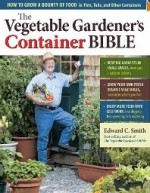 Living in an apartment or townhouse doesn’t mean you can’t grow your own vegetables. Many vegetables can be grown in pots including all time favorites like tomatoes and peppers. If you have a sunny place such as a deck, driveway, or sidewalk you can grow a considerable amount and variety of vegetables. And even if you have an in-ground vegetable garden you might want to try some containers to provide easy to grab salad fixings or so you can prolong the growing season by bringing plants inside when frost threatens. Edward C. Smith’s book, will help you get started with suggestions and tips for all phases of the process.
Living in an apartment or townhouse doesn’t mean you can’t grow your own vegetables. Many vegetables can be grown in pots including all time favorites like tomatoes and peppers. If you have a sunny place such as a deck, driveway, or sidewalk you can grow a considerable amount and variety of vegetables. And even if you have an in-ground vegetable garden you might want to try some containers to provide easy to grab salad fixings or so you can prolong the growing season by bringing plants inside when frost threatens. Edward C. Smith’s book, will help you get started with suggestions and tips for all phases of the process.
The book is divided into three sections. The first deals with pots, soil, and tools. Smith considers a range of pots from found objects and DIY containers to traditional store-bought pots. He gives step by step directions with numerous photographs for making a self-watering pot out of a plastic bucket and a storage bin. In a chapter on soil, he discusses the special requirements of soil for a container and gives guidelines for mixing your own potting soil. The tools for container vegetable gardening are listed and described including a soil thermometer, watering devices, and trellises.
The second section takes the reader through the process of planting and caring for the container garden. One chapter is devoted to designing containers so that they are both productive and beautiful. Smith suggests using colorful varieties of vegetables, like ‘Bright Lights’ Swiss chard or ‘Red Sails’ lettuce, to brighten the containers before the main crop of veggies develop and he gives seven examples of pots planted with a variety of vegetables and herbs with accompanying photographs. In a more practical vein, Smith suggests that if you live high in an apartment, the bees and other pollinators will not visit your plants and you will have to do the job yourself. Directions for staking plants, pest control, harvesting, container storage, and recycling the soil complete the section.
The third section gives detailed instructions for growing vegetables, herbs, and edible flowers. Smith gives information on the choosing the correct pot, growing the plant, harvesting the fruit, and eating it. He also includes a list and description of the best varieties to grow. Smith also identifies 22 vegetables and 5 herbs that he has found do better in his self-watering containers than in his in-ground garden.
The book is written in an easy to understand, conversational style and is richly illustrated with photographs showing everything from tools to containers full of mouth watering vegetables. Inserts enhance the text with interesting facts such as a tomato plant will use up to a gallon of water a day during the hottest part of the summer. If you are new to container gardening and want to grow vegetables, this is an informative and enjoyable source of information.